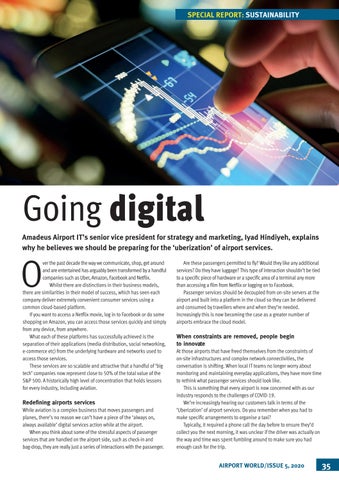SPECIAL REPORT: SUSTAINABILITY
Going digital Amadeus Airport IT’s senior vice president for strategy and marketing, Iyad Hindiyeh, explains why he believes we should be preparing for the ‘uberization’ of airport services.
O
ver the past decade the way we communicate, shop, get around and are entertained has arguably been transformed by a handful companies such as Uber, Amazon, Facebook and Netflix. Whilst there are distinctions in their business models, there are similarities in their model of success, which has seen each company deliver extremely convenient consumer services using a common cloud-based platform. If you want to access a Netflix movie, log in to Facebook or do some shopping on Amazon, you can access those services quickly and simply from any device, from anywhere. What each of these platforms has successfully achieved is the separation of their applications (media distribution, social networking, e-commerce etc) from the underlying hardware and networks used to access those services. These services are so scalable and attractive that a handful of ‘big tech’ companies now represent close to 50% of the total value of the S&P 500. A historically high level of concentration that holds lessons for every industry, including aviation.
Redefining airports services While aviation is a complex business that moves passengers and planes, there’s no reason we can’t have a piece of the ‘always on, always available’ digital services action while at the airport. When you think about some of the stressful aspects of passenger services that are handled on the airport side, such as check-in and bag-drop, they are really just a series of interactions with the passenger.
Are these passengers permitted to fly? Would they like any additional services? Do they have luggage? This type of interaction shouldn’t be tied to a specific piece of hardware or a specific area of a terminal any more than accessing a film from Netflix or logging on to Facebook. Passenger services should be decoupled from on-site servers at the airport and built into a platform in the cloud so they can be delivered and consumed by travellers where and when they’re needed. Increasingly this is now becoming the case as a greater number of airports embrace the cloud model.
When constraints are removed, people begin to innovate At those airports that have freed themselves from the constraints of on-site infrastructures and complex network connectivities, the conversation is shifting. When local IT teams no longer worry about monitoring and maintaining everyday applications, they have more time to rethink what passenger services should look like. This is something that every airport is now concerned with as our industry responds to the challenges of COVID-19. We’re increasingly hearing our customers talk in terms of the ‘Uberization’ of airport services. Do you remember when you had to make specific arrangements to organise a taxi? Typically, it required a phone call the day before to ensure they’d collect you the next morning, it was unclear if the driver was actually on the way and time was spent fumbling around to make sure you had enough cash for the trip.
AIRPORT WORLD/ISSUE 5, 2020
35
